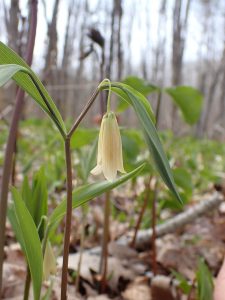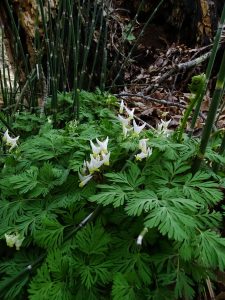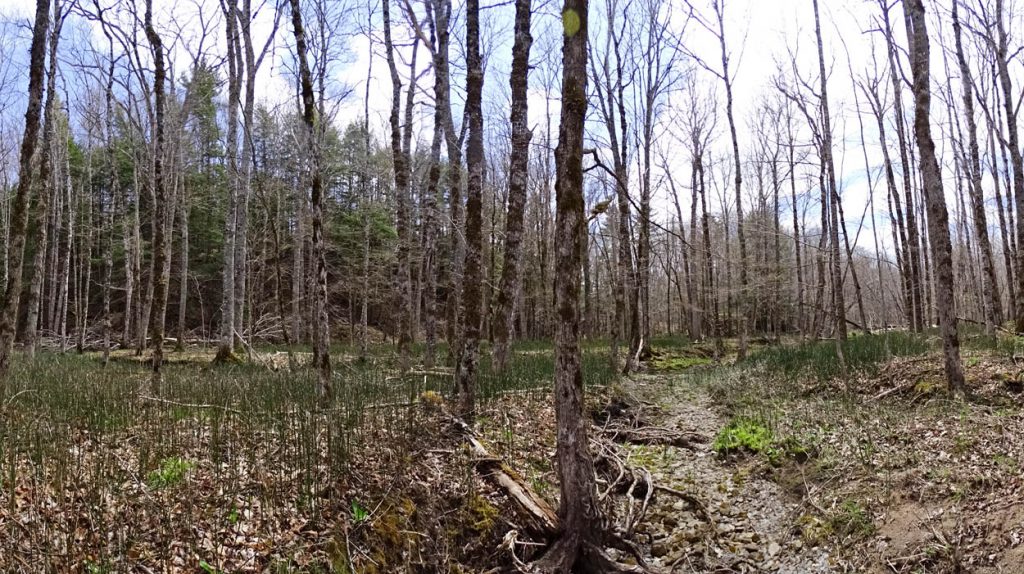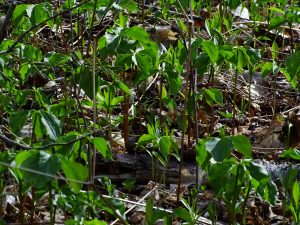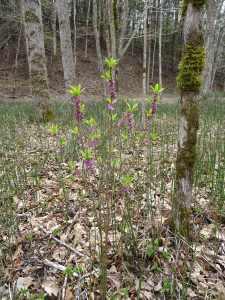I went with a friend for for a walk yesterday in some intervale (floodplain) forests in Hant’s Co. not too far away. We found what we wanted to see: the first wave of forest herbs that flower before the hardwoods leaf out.
Most special was a patch of Sessile-leaf Bellwort (Uvularia sessilifolia), about which Henry David Thoreau wrote in 1852*
_______________
*As cited by Martha on wildflowergardener.wordpress.com April 26, 2014
The sessile-leaved bellwort, with three or four delicate pale-green leaves with reflexed edges, on a tender-looking stalk, the single modest-colored flower gracefully drooping, neat, with a fugacious, richly spiced fragrance, facing the ground, the dry leaves, as if unworthy to face the heavens. It is a beautiful sight, a pleasing discovery, the first of the season, — growing in a little straggling company, in damp woods or swamps. When you turn up the drooping flower, its petals make a perfect geometrical figure, a six-pointed star
Other herbs in flower on the wet forest floor below the hardwoods were Dutchman’s-breeches, Yellow Violet, Bloodroot, and the signature Acadian settler shrub, Daphne. There were broad sweeps everywhere of Nodding Trillium with flower buds ready to go after a few days of warmth; and patches of Blue Cohosh, Wild Leek and Toothwort yet to flower.
At one site, the landowner, a farmer, came down to see what we were up-to; he had been told some folks had been seen heading down to the area where he harvests fiddlehead ferns… it turned out he knew the friend who was with me and had long ago approved our botanizing there. He knew about and kept guard over the rare plants in the area as well as his fiddleheads.
These were magnificent intervale hardwood stands, typically 100-200 m wide by the river, in general dominated by White Ash, some co-dominantly with Red Oak or Sugar Maple, all with Red maple, various amounts of Yellow Birch and occasional White Pine. One yellow birch was well over 3 ft dbh. Hemlock dominated on some of the steep banks by the intervale forests.
Nova Scotia’s intervale forests were abundant in our “well-rivered” N.S. in the days when they were all under the care of our First Nations peoples. They were decimated as the European settlers cleared them for farming, and ongoing until fairly recently by residential and commercial development. (We seem, finally, to have learned not to build on our floodplains.) Those we have left are precious.
So here is the really sad part. Within the last several years, exotic pests that will likely sooner or later take down both the intervale ash and the hemlock on the embankments arrived in NS. I am not sure what I will see if I am so fortunate to visit these areas again a decade from now.
But yesterday, I didn’t think too much about such things; for a few hours, I completely forgot about covid-19 and a lot else that causes so much anxiety these days.
I know that’s a lot of what a lot of Nova Scotians appreciate about our still intact forests, wherever they are.
Now if only LANDS & Forestry could institute a 150-200 m buffer on all rivers and begin to re-establish some of those floodplain forests long lost…
A few links
Two small Uvularias – Mountain Bellwort & Wild Oats
by Martha on Nantahala Natives, Apr 26, 2014
The True Spring Ephemerals in Nova Scotia
Photo-essay by JackPine on nswildflora.ca Apr 4, 2012
Intervale Travails
Post on NSFN, July 18, 2016
Big Win For Biodiversity on the St. Mary’s — Welcome News Amidst Growing Global Crisis
Nova Scotia Nature Trust May 24, 2019

